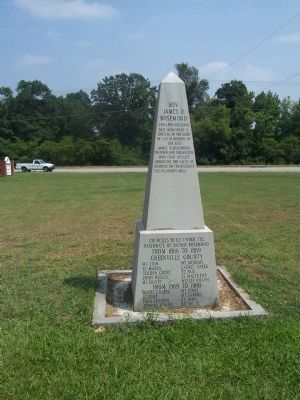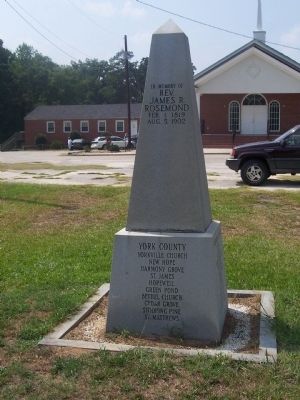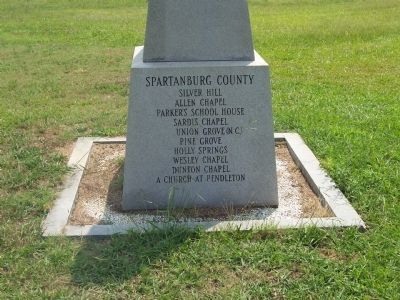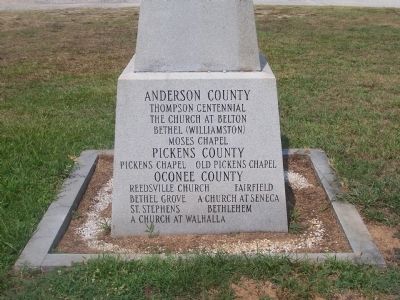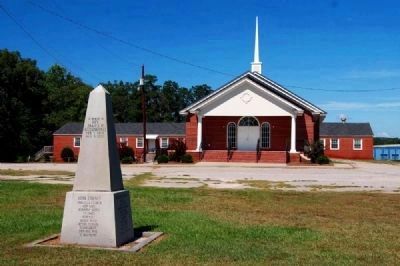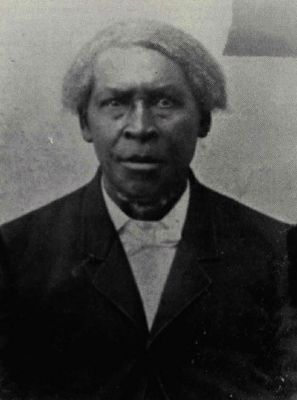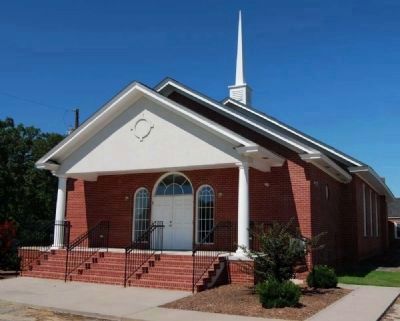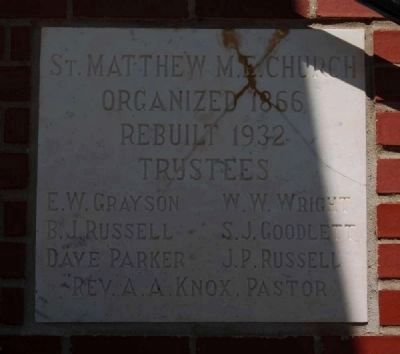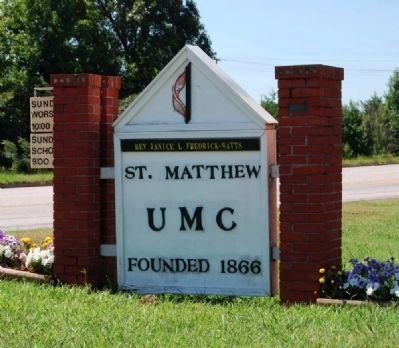Greenville in Greenville County, South Carolina — The American South (South Atlantic)
Rev. James R. Rosemond
[West side of marker]:
This monument is
erected to the glory
of God in memory of
the Rev.
James R. Rosemond,
founder and organizer,
who gave his life
advancing the cause of
Methodism throughout
the Piedmont area.
Churches built under the
Pastorate of Father Rosemond
From 1866 to 1869
Greenville County
Mt. Zion
Mt. Moriah
St. Marks
Laurel Creek
Golden Grove
St. Paul
John Wesley
St. Matthews
Mt. Olivet
Wesley Chapel
From 1869 to 1900
Moses Chapel
Mt Sinai
St. Luke
Mt. Carmel
Fork Church
St. John
Jenkins Chapel
Bethel II
[East side of marker]:
Rev.
James R.
Rosemond
Feb. 1, 1819
Aug. 5, 1902
York County
Yorkville Church
New Hope
Harmony Grove
St. James
Hopewell
Green Pond
Bethel Church
Cedar Grove
Stooping Pine
St. Matthews
[North side of marker]:
Silver Hill
Allen Chapel
Parker School House
Sardis Chapel
Union Grove (N.C.)
Pine Grove
Holly Springs
Wesley Chapel
Dunton Chapel
A Church at Pendleton
[South side of marker]:
Thompson Centennial
The Church at Belton
Bethel (Williamston)
Moses Chapel
Pickens County
Pickens Chapel
Old Pickens Chapel
Oconee County
Reedsville Church
Fairfield
Bethel Grove
A Church at Seneca
St. Stephens Bethlehem
A Church at Walhalla
Topics. This historical marker is listed in these topic lists: African Americans • Churches & Religion. A significant historical date for this entry is February 1, 1851.
Location. 34° 54.637′ N, 82° 20.308′ W. Marker is in Greenville, South Carolina, in Greenville County. Marker is on Old Rutherford Road south of Tanner Street, on the right when traveling south. Touch for map. Marker is at or near this postal address: 2507 Rutherford Road, Greenville SC 29609, United States of America. Touch for directions.
Other nearby markers. At least 10 other markers are within 3 miles of this marker, measured as the crow flies. Camp Sevier (approx. ¾ mile away); a different marker also named Camp Sevier (approx. 1.7 miles away); The Dam for Reservoir 2 (approx. 2 miles away); What's So Special About this Bridge? (approx. 2 miles away); Welcome to Paris Mountain State Park (approx. 2.1 miles away); New Life for Old Bathhouse (approx. 2.1 miles away); Come On In, the Water's Fine! (approx. 2.1 miles away); Taylors First Baptist Church (approx. 2.1 miles away); "Mom, Can I Have a Nickel?" (approx. 2.1 miles away); Open to the Sky (approx. 2.2 miles away). Touch for a list and map of all markers in Greenville.
Regarding Rev. James R. Rosemond. Under the direction and Pastorate of Rev. Rosemond, more than two dozen churches in at least six counties in the upstate of South Carolina were constructed.
Additional commentary.
1. Formation of Black Churches
Much more lasting than political power in the hands of the freedmen was the formation of black churches. The leading spirit in establishing black Methodism in Greenville was the Reverend James R. Rosemond. Known only as Jim when he was born on February 1, 1820, he was the son of Abraham and Peggy, who were slaves of Waddy Thompson, Jr. When Jim was six, his parents were sent to Alabama with one of Thompson's sons. Jim remained in Greenville and went to live with a family of Methodists under whose influence he was baptized in 1844. The following year he became a class leader. In 1851 Jim gained permission of the church to travel with the black Baptist preacher, Gabriel Poole. On September 12, 1854, Osgood A. Darby, pastor of the Greenville Methodist Church, recommended Jim as a "Colored preacher." The next Sunday he preached his first sermon at Salem Church near the Saluda River. He preached regularly at Sharon Church in the Anderson District, and the congregation collected funds to purchase his freedom. His owner, Vardry McBee, agreed to the price of eight hundred dollars, but the church raised only five hundred dollars before the Civil War. According to his biographer, Jim received his "freedom without pay" through emancipation. A note in the church records of the Greenville Methodist Church in 1862 indicates that "among the colored people you will find a person, Jim McBee, who has been allowed to preach for the last ten or eleven years. "
After the Civil War Jim took the name James R. Rosemond, and he soon gathered a group of black Methodists in Greenville to establish a church-Frank Williamson, Wilson Cooke, Alexander Maxwell, and Wiley Pool. According to one account, the group first met at Cooke's house and agreed to pay the trustees of the Greenville Methodist Church one hundred dollars a year to meet there weekly. When Charles Hopkins arrived and opened the Freedmen's Bureau School, the black congregation began to meet at the schoolhouse. In 1866 T. Willard Lewis, one of the white leaders sent to South Carolina by the Methodist Episcopal Church, purchased for $225 a lot from Alexander McBee on the hill west of the residence of William Choice. According to the local newspaper, McBee "sold them the land for $50 less than it was worth," and by February 1869 a building seating five hundred people had been constructed by Cline & Gibbs. The church had three hundred members and held three services on Sundays and a prayer meeting on Thursday nights. Frank Williamson served as superintendent of the Sunday school. At first the church was known as Silver Hill, but in 1902 the name was changed to John Wesley Church.
In January 1867 Rosemond entered the Baker Theological Institute in Charleston, a forerunner of Claflin College, and after one term he was ordained a deacon under the missionary rule. Rosemond returned to Greenville and began to establish churches-first St. Matthew near Chicle Springs, and then St. Mark near Travelers Rest, where a camp meeting was held every year. Later he organized Wesley Chapel and Golden Grove and began to travel more widely into neighboring counties where he established more churches. In 1868 he was ordained an elder, and before his death in 1902 he established fifty churches from York to Oconee.
Prior to the Civil War Rosemond had traveled
with Gabriel Poole, who played a leading role in organizing black Baptist churches in Greenville. On February 1,1842, the black members of the Greenville Baptist Church selected Gabriel, as he was then known, who was a slave belonging to the Cleveland family, to assist "Isaac, a servant of Dr. Thos. B. Williams" in overseeing the black members and to serve them communion. After refusing one black member a license to preach, the church granted a license to Gabriel on October 24, 1847.
The ambiguous status of the black membership in the Greenville Baptist Church after the Civil War was indicated in November 25,1867, when the congregation voted "to have the slaves (Negroes) put up in the body of the Church." Five months later, on April 21, 1868, Dr. James P. Boyce reported that sixty-five black members requested dismissal from the church to establish a separate congregation. Among those listed in the minutes, with family names for the first time, was Gabriel Poole. Perhaps the wealthiest member of the group was Dudley Talley, a drayman, whose wealth was listed in the 1870 census as $1,050. A month later sixteen other members joined the group.
For five years the new congregation met in the basement of the Greenville Baptist Church and held services on Friday evenings and Sunday afternoons. In May 1867 Gabriel Poole was ordained "a regular Minister by the Elders of the Greenville Baptist Church" along with four black deacons. Dr. Basil Manly, Sr., "on a visit to Greenville, took part in the ordination." On Sunday, September 10, 1871, the first service was held in the new Springfield Baptist Church on McBee Avenue. According to the newspaper account, "some whites attended," and James P. Boyce preached the first sermon in the new house of worship. By October 1875 the Springfield church had about five hundred members.
Black churches of other denominations were formed in Greenville in succeeding years. The Enterprise reported on June 15, 1870, that a black woman preacher from Virginia had delivered a sermon in the courthouse, "endeavoring to raise funds in the interest of the African Methodist Episcopal Church." Her efforts were not immediately successful, and in 1879 Allen Temple AME Church was organized by R. W. Sinclair. In January 1881 the congregation purchased the former Gaillard School in West Greenville for two thousand dollars. James T. Baker was pastor, and the trustees were J.M. Chiles, Joseph Plumer, E.G. Griffin, Sr., C. Ward, and Dercy Watt. The stewards were William Brown, June Hanes, Henry Down, and James H. Chiles. S. Mattoon organized the Mattoon Presbyterian Church with seven members in 1878, and the Israel Metropolitan Colored (now Christian) Methodist Episcopal Church was founded in 1891 by A.J. Stinson.
With the end of political Reconstruction in Greenville, the black schools and churches survived as the most tangible results of the effort of blacks to maintain their freedom and improve their status in the New South. (Source: Greenville: The History of the City and County in the South Carolina Piedmont by Archie Vernon Huff, Jr. (1995) pgs 171-174.)
— Submitted November 5, 2009, by Brian Scott of Anderson, South Carolina.
Credits. This page was last revised on December 13, 2019. It was originally submitted on September 1, 2008, by M. L. 'Mitch' Gambrell of Taylors, South Carolina. This page has been viewed 2,651 times since then and 66 times this year. Photos: 1, 2, 3, 4. submitted on September 1, 2008, by M. L. 'Mitch' Gambrell of Taylors, South Carolina. 5, 6, 7, 8, 9. submitted on November 5, 2009, by Brian Scott of Anderson, South Carolina. • Christopher Busta-Peck was the editor who published this page.
